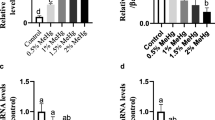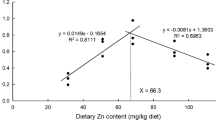Abstract
Triplicate groups of sea cucumbers (4.83 ± 0.15 g) were exposed to one of the four nominal concentrations of dietary mercury [0 (control), 67.6, 338, and 676 mg/kg dry weight, and actually total mercury were 17.55, 87.00, 275.50, 468.50 mg/kg, respectively; Table 3] for 21 days. Mercury accumulation in the intestine showed the greatest mercury burden (77.96 ± 1.20 mg Hg/kg tissue wet weight basis). However, survival rate (SR) was not affected. Body weight gain after the 676 mg Hg/kg treatment was significantly lower than the control group. The feed conversion rate of the 676 mg Hg/kg treatment group was significantly higher than the control group. Additionally, the superoxide dismutase (SOD) and total antioxidant capacity (T-AOC) of sea cucumbers decreased as the mercury dose increased. SOD, T-AOC and alkaline phosphatase of the 676 mg Hg/kg treatment group were significantly lower than the control group. However, there were no significant differences between the four groups in acid phosphatase and catalase (CAT) activity.

Similar content being viewed by others
References
Amlund H, Lundebye AK, Berntssen MH (2007) Accumulation and elimination of methylmercury in Atlantic cod (Gadus morhua L.) following dietary exposure. Aquat Toxicol 83:323
Bernhoft RA (2012) Mercury toxicity and treatment: a review of the literature. J Environ Public Health 2012:460508
Berntssen MHG, Hylland K, Julshamn K, Lundebye AK, Waagbo R (2015) Maximum limits of organic and inorganic mercury in fish feed. Aquac Nutr 10:83–97
Bossuyt BTA, Janssen CR (2004) Long-term acclimation of Pseudokirchneriella subcapitata (Korshikov) Hindak to different copper concentrations: changes in tolerance and physiology. Aquat Toxicol 68:61
Carvalho CM, Chew EH, Hashemy SI, Lu J, Holmgren A (2008) Inhibition of the human thioredoxin system. A molecular mechanism of mercury toxicity. J Biol Chem 283:11913–11923
Chen L, Zhang J, Zhu Y, Zhang Y (2015) Molecular interaction of inorganic mercury(II) with catalase: a spectroscopic study in combination with molecular docking. RSC Adv 5:79874–79881
Cheng J-H, Wang J-J, Yang F-L, Song Y, Yu-Kun (2013) Purification and characterization of alkaline phosphatase from the gut; of sea cucumber Stichopus japonicus. Fish Sci 79:477–485
Elia AC, Galarini R, Taticchi MI, Dörr AJ, Mantilacci L (2003) Antioxidant responses and bioaccumulation in Ictalurus melas under mercury exposure. Ecotoxicol Environ Saf 55:162
Finkel T, Holbrook NJ (2000) Oxidants, oxidative stress and biology of ageing. Nature 408:239–247
French KJ, Scruton DA, Anderson MR, Schneider DC (1999) Influence of physical and chemical characteristics on mercury in aquatic sediments. Water Air Soil Pollut 110:347–362
Góth L (1991) A simple method for determination of serum catalase activity and revision of reference range. Clin Chim Acta 196:143
Guilherme S, Válega M, Pereira ME, Santos MA, Pacheco M (2008) Antioxidant and biotransformation responses in Liza aurata under environmental mercury exposure—relationship with mercury accumulation and implications for public health. Mar Pollut Bull 56:845–859
Hao LU, Zhang H, Zhao BY, Wei DM, Song YY (2012) Effect of mercuric chloride on oxidative damage of brain tissues in SD rats. Chin J Vet Sci 32:122–124
Harada M (1995) Minamata disease: methylmercury poisoning in Japan caused by environmental pollution. Crit Rev Toxicol 25:1
Hoyle I, Handy RD (2005) Dose-dependent inorganic mercury absorption by isolated perfused intestine of rainbow trout, Oncorhynchus mykiss, involves both amiloride-sensitive and energy-dependent pathways. Aquat Toxicol 72:147
Huang YH, Shih CM, Huang CJ, Lin CM, Chou CM, Tsai ML, Liu TP, Chiu JF, Chen CT (2006) Effects of cadmium on structure and enzymatic activity of Cu, Zn-SOD and oxidative status in neural cells. J Cell Biochem 98:577
Huang ZY, Zhang Q, Chen J, Zhuang ZX, Wang XR (2007) Bioaccumulation of metals and induction of metallo-thioneins in selected tissues of common carp (Cyprinus carpio L.) co-exposed to cadmium, mercury and lead. Appl Organomet Chem 21:101–107
Hussain S, Rodgers DA, Duhart HM, Ali SF (1997) Mercuric chloride-induced reactive oxygen species and its effect on antioxidant enzymes in different regions of rat brain. J Environ Sci Health B 32:395
Jiang GB, Shi JB, Feng XB (2006) Mercury pollution in China. Environ Sci Technol 40:3672–3678
Jiang H, Tang S, Qin D, Chen Z, Wang J, Bai S, Mou Z (2015) Heavy metals in sea cucumber Juveniles from Coastal Areas of Bohai and Yellow Seas, North China. Bull Environ Contam Toxicol 94:577
Jiaxin C (2004) Present status and prospects of sea cucumber industry in China. Fao Fisheries Technical Paper
Lian X (1997) Effect of exogenous superoxide dismutase on immune toxicity by mercuric chloride. Zhongguo Gonggong Weisheng Xuebao, 16(3):190–192
Liu G, Cai Y, O’Driscoll N (2011) Environmental chemistry and toxicology of mercury. Electrochim Acta 52:453–499
Long Z, Xin J, Hou X (2004) Determination of arsenic and mercury in Chinese medicinal herbs by atomic fluorescence spectrometry with closed-vessel microwave digestion. Spectrosc Lett 37:263–274
Malamy M, Horecker BL (1966) [113] Alkaline phosphatase (crystalline). Methods Enzymol 9:639–642
Mason RP, Reinfelder JR, Morel FMM (1995) Bioaccumulation of mercury and methylmercury. Water Air Soil Pollut 80:915–921
Monteiro DA, Rantin FT, Kalinin AL (2010) Inorganic mercury exposure: toxicological effects, oxidative stress biomarkers and bioaccumulation in the tropical freshwater fish matrinxã, Brycon amazonicus (Spix and Agassiz, 1829). Ecotoxicology 19:105
Nazeemul K (2011) Sublethal effects of mercury on growth and biochemical com position and their recovery in Oreochromis mossambicus. Indian J Fish 38:111–118
Niu LY, Jiang ST, Pan LJ (2013) Preparation and evaluation of antioxidant activities of peptides obtained from defatted wheat germ by fermentation. J Food Sci Technol 50:53–61
Oliveira Ribeiro CA, Pelletier E, Pfeiffer WC, Rouleau C (2000) Comparative uptake, bioaccumulation, and gill damages of inorganic mercury in tropical and nordic freshwater fish. Environ Res 83:286–292
Oyanagui Y (1984) Reevaluation of assay methods and establishment of kit for superoxide dismutase activity. Anal Biochem 142:290–296
Peng D (2012) Determination of Hg in feed additives by atomic fluorescence spectrometry. Chin J Spectrosc Lab 1:055
Purcell SW, Lovatelli A, Vasconcellos M, Ye YM (2010) Managing sea cucumber fisheries with an ecosystem approach. FAO, Rome
Rui WU, Kang S, Liu H, Wang W, Liu L (2001) Selection of diagnostic index on experimental mercury poisoning in chickens. Prog Vet Med 22:67–69
Sara B, Farooq A, Nazamid S (2011) High-value components and bioactives from sea cucumbers for functional foods—a review. Marine Drugs 9:1761–1805
Stec B, Holtz KM, Kantrowitz ER (2000) A revised mechanism for the alkaline phosphatase reaction involving three metal ions. J Mol Biol 299:1303–1311
Tewary A, Patra BC (2008) Use of vitamin C as an immunostimulant. Effect on growth, nutritional quality, and immune response of Labeo rohita (Ham.). Fish Physiol Biochem 34:251
Wang Q, Kim D, Dionysiou DD, Sorial GA, Timberlake D (2004) Sources and remediation for mercury contamination in aquatic systems—a literature review. Environ Pollut 131:323–336
Wang Y, Kang WL, Xin SG, Xing WQ (2009) Analysis study of trace elements in abalone and sea cucumber. Spectrosc Spectr Anal 29(514):511–514
Wang J, Ren T, Wang F, Han Y, Liao M, Jiang Z, Liu H (2016) Effects of dietary cadmium on growth, antioxidants and bioaccumulation of sea cucumber (Apostichopus japonicus) and influence of dietary vitamin C supplementation. Ecotoxicol Environ Saf 129:145
Zhao Y, Zhang L, Wang X, Qin Y, Zheng B (2012) Effects of Hg~(2+) on activities of enzyme in hepatopancreas and haemolymph of Chinese Mitten Crab, Eriocheir sinensis. Asian J Ecotoxicol 7:620–626
Acknowledgements
This work was funded by the Public Science and Technology Research Fund Project of Ocean of the State Oceanic Administration of the People’s Republic of China (Grant No. 201405003) and the Science and Technology Research Fund Project of the Dalian City Oceanic and Fishery Administration, Liaoning Province, China (Grant No. 20140101).
Author information
Authors and Affiliations
Corresponding authors
Rights and permissions
About this article
Cite this article
Li, Z., Ren, T., Han, Y. et al. The Effects of Sub-lethal Dietary Mercury on Growth Performance, Bioaccumulation, and Activities of Antioxidant Enzymes in Sea Cucumber, Apostichopus japonicus. Bull Environ Contam Toxicol 100, 683–689 (2018). https://doi.org/10.1007/s00128-018-2321-9
Received:
Accepted:
Published:
Issue Date:
DOI: https://doi.org/10.1007/s00128-018-2321-9




